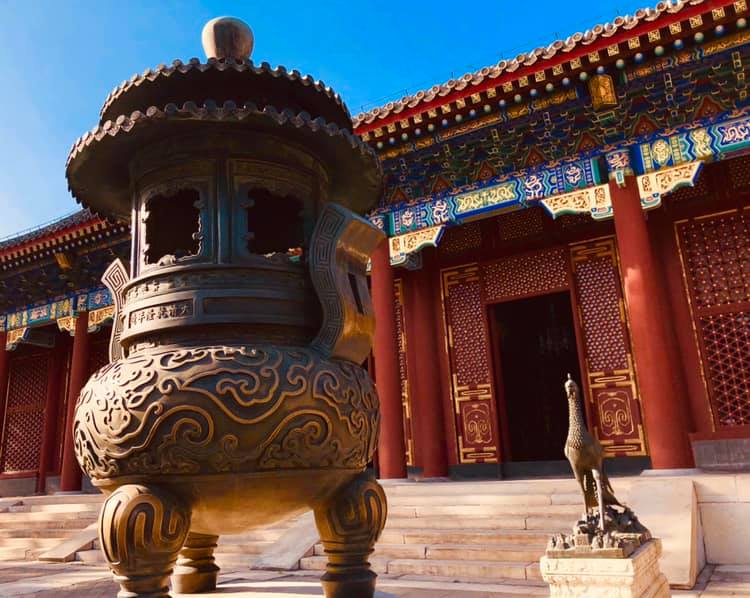“Yiheyuan” 颐和园 (Summer Palace of Beijing) is an imperial garden from the Qing Dynasty. Built in 1764 as “Qingyiyuan” 清漪园 during the reign of the Emperor Qianlong. It was burned down towards the end of the Second Opium War by the Anglo-French troops and was reconstructed in 1888 by the Guanxu Emperor to celebrate the 60th birthday of Empress Dowager Cixi, adopting its present name. It is a UNESCO World Heritage Site, recognized for “its harmonious ensemble of outstanding aesthetic value”.

Deheyuan 德和园 is located steps away from the East (main) entrance of the park.

It is the place where the Empress Dowager Cixi – who is a fervent Peking Opera lover – hosted the performances to the princes, imperial consorts and high ranking officials.

The three-story opera stage is one of the top three opera stages in the Qing Dynasty – The other two are Changyinge 畅音阁 in the Forbidden City and Qingyinge 清音阁 in the Chengde Mountain Resort.

All three levels of the stages are connected allowing the performers, who in the role of ghosts or immortals, to “rise from earth” or “descend from heaven“. There are also five water tanks underneath the stage, serving as reservoir for props such as rain or water fountains.
The Hall of Joy and Longevity 乐寿堂 is the living quarters of the Empress. There are statues of bronze deers, cranes, and vases in front of the hall.

To understand the significance of these statues, let’s take a look at their homonyms in Chinese: Deer 鹿 ->六 Six, Crane 鹤 ->合 Union, Vase 瓶 ->平 Peace. Deer and Crane 六合 suggest the kingdom or the realm of Emperor. Together the statues signify A peaceful ruling 六合太平, and thereby, joy and longevity to the Empress.
There are also two prized magnolia tress in the courtyard from the Qianlong Era.

It was said that the Empress Dowager Cixi‘s maiden name is magnolia therefore she took these trees very seriously.
Stepping outside the Hall of Joy and Longevity come to a large body of water that is Kunming Lake 昆明湖. In front of it is the famous Long Corridor 长廊.

The corridor is 728 meters long. It contains paintings of famous places in China, and scenes from Chinese mythologies and folktales.

Situated to the right of the Long Corridor and at foot of the Longevity Hill 万寿山 is the Hall of Dispelling Clouds 排云殿

This is where the Empress Dowager received guests during her stay in the Summer Palace.

From here it is a climb to the Tower of Buddhist Incense 佛香阁

With its elaborated hallways
and flying corridors

At the top, a panoramic view of the park and its surroundings await.





How wonderful! Great pictures. I was in the Summer Palace this autumn but far to short. You seen many things I didn’t have the chance to see, or have taken the time for it. I’m looking forward to the next images.
LikeLiked by 1 person
Thank you! We spent a whole day there. I love that park. Another of my favorite is the Beihai Park. I was there this autumn as well. When were you there? Maybe we passed each other 🙂
LikeLiked by 1 person
I was there saturday 8 september. Maybe we did pass each other 🙂
LikeLiked by 1 person
I was there two months later :). September is a great month to travel in China!
LikeLiked by 1 person
Stunning! The Summer Palace is incredibly gorgeous, not to forget immense! Really, you could spend days just wandering the palace, along with its garden. Definitely a national gem, and it’s great you got to cover every corner of it. 🙂
LikeLiked by 1 person
Thanks Rebecca!
LikeLiked by 1 person
Stunning! Love the beautiful architecture 🙂
LikeLiked by 1 person
Thanks Len. Merry Christmas 🎁🎄
LikeLiked by 1 person
Thanks! Wish you and your family wonderful holiday! 😀
LikeLiked by 1 person
Brilliant and fantastic presentation of the palace and what a historical architecture. Awesome.
LikeLiked by 1 person
Fabulous – always wonderful to read your travel stories and see the photos.
LikeLiked by 1 person
Thank you brilliantviewpoint!
LikeLiked by 1 person
Such detail in the patterns. I think about the time, the people and the craft.
LikeLiked by 1 person
How amazing! China is def on our list one day. Hope you are doing good. I haven’t been on WP in awhile.
LikeLiked by 1 person
So intricate, elaborate, and beautiful.
LikeLiked by 1 person